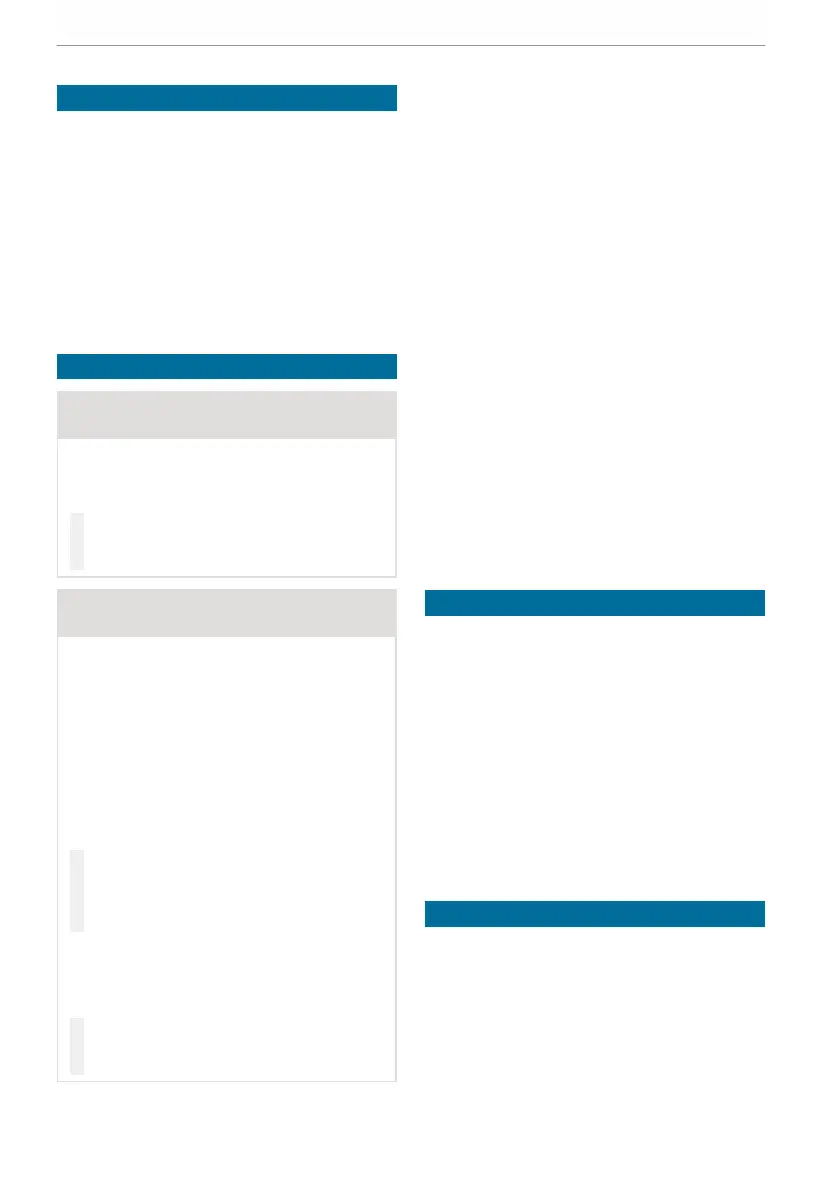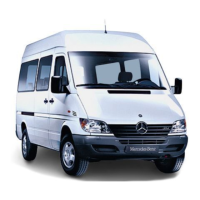Noise or unusual driving characteristics
While driving, pay attention to vibrations, noises
and unusual driving characteristics, e.g. pulling to
one side. This may indicate damage to the wheels
or tyres. If you suspect that a tyre is defective,
reduce your speed. Stop the vehicle as soon as
possible to check the wheels and tyres for dam‐
age. Hidden tyre damage could also be causing
the unusual driving characteristics. If no signs of
damage can be detected, have the tyres and
wheels checked at a qualified specialist work‐
shop.
Regular checking of wheels and tyres
&
WARNING Risk of accident from dam‐
aged tyres
Damaged tyres can cause tyre pressure loss.
As a result, you could lose control of your
vehicle.
#
Check the tyres regularly for signs of
damage and replace any damaged tyres
immediately.
&
WARNING Risk of aquaplaning due to
insufficient tyre tread
Insufficient tyre tread will result in reduced
tyre grip. The tyre tread is no longer able to
dissipate water.
This means that in heavy rain or slush the risk
of aquaplaning is increased, in particular
where speed is not adapted to suit the condi‐
tions.
If the tyre pressure is too high or too low,
tyres may exhibit different levels of wear at
different locations on the tyre tread.
#
Thus, you should regularly check the
tread depth and the condition of the
tread across the entire width of all
tyres.
Minimum tread depth for:
R
Summer tyres: 3 mm
R
M+S tyres: 4 mm
#
For safety reasons, replace the tyres
before the legally prescribed limit for
the minimum tread depth is reached.
Check the wheels and tyres of your vehicle for
damage regularly, i.e. at least every two weeks,
as well as after driving off-road or on rough
roads. Damaged wheels can lead to a loss of tyre
pressure.
Pay attention to damage such as:
R
cuts in the tyres
R
punctures in the tyres
R
tears in the tyres
R
bulges on tyres
R
deformation or severe corrosion on wheels
Conduct the following checks regularly, at least
once a month or as required, e.g. before a long
journey or when driving off-road, on all wheels:
R
check the tyre pressure (→ page 303).
R
check the valve caps
Valves must be protected from moisture and
dirt with valve caps specifically approved by
Mercedes-Benz for your vehicle.
R
visually inspect the tread depth and the tyre
tread across the whole tyre width
For summer tyres, the minimum tread depth
is 3 mm and for winter tyres 4 mm.
Information on driving with summer tyres
At temperatures below 10 °C summer tyres lose
elasticity and therefore traction and braking
power. Change the tyres on your vehicle to M+S
tyres. Using summer tyres at very cold tempera‐
tures could cause tears to form, thereby damag‐
ing the tyres permanently. We cannot accept
responsibility for this type of damage.
Always observe the maximum permitted speed
specified for the summer tyres you have fitted .
Once you have fitted the summer tyres:
R
Check the tyre pressure (→ page 303)
R
Restart tyre pressure monitor (→ page 315)
Information on M+S tyres
Use winter tyres or all-season tyres at tempera‐
tures below 10 °C. Both types of tyre are identi‐
fied by the M+S marking.
Only winter tyres bearing the i snowflake
symbol in addition to the M+S marking provide
the best possible grip in wintry road conditions.
Only these tyres will allow driving safety systems
such as ABS and ESP
®
to function optimally in
winter. These tyres have been developed specifi‐
cally for driving in snow.
Wheels and tyres
301

